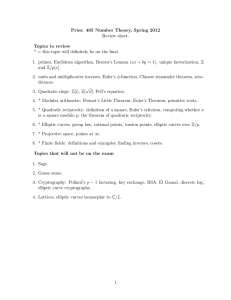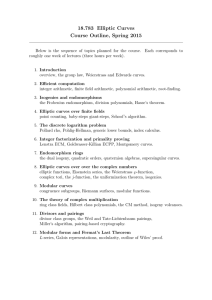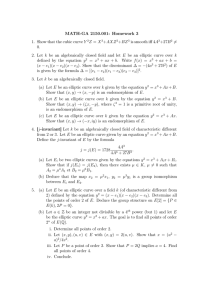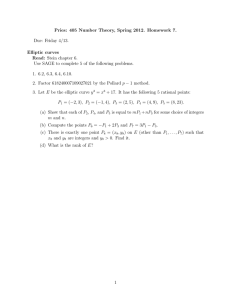14 Ordinary and supersingular elliptic curves 18.783 Elliptic Curves Spring 2015
advertisement
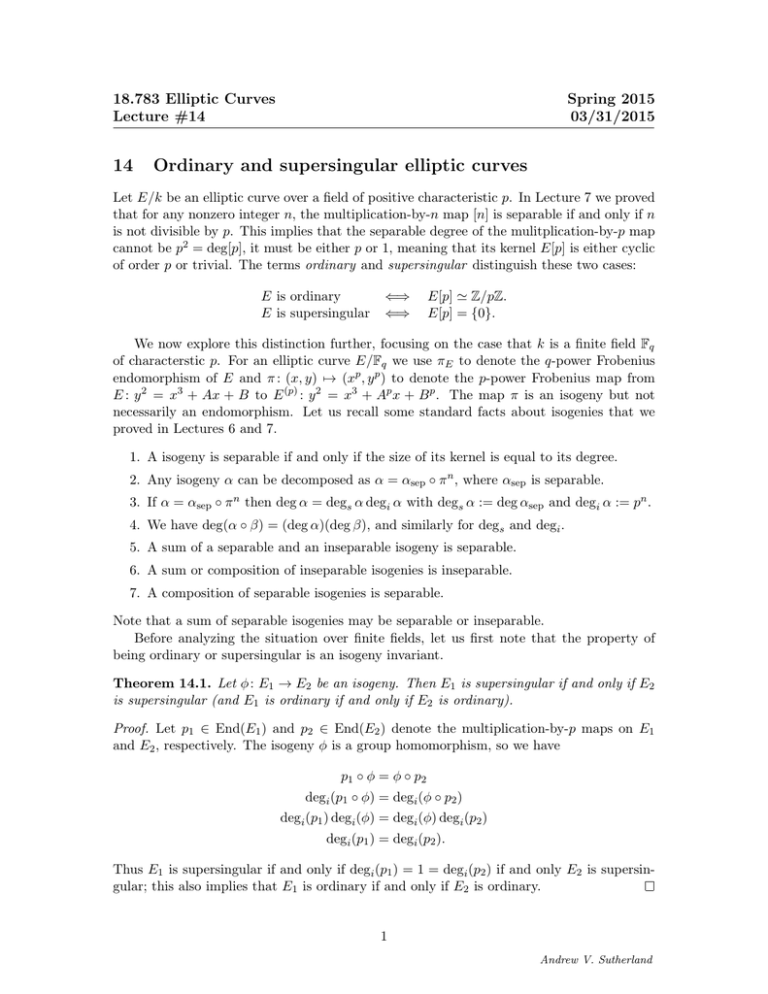
18.783 Elliptic Curves
Lecture #14
14
Spring 2015
03/31/2015
Ordinary and supersingular elliptic curves
Let E/k be an elliptic curve over a field of positive characteristic p. In Lecture 7 we proved
that for any nonzero integer n, the multiplication-by-n map [n] is separable if and only if n
is not divisible by p. This implies that the separable degree of the mulitplication-by-p map
cannot be p2 = deg[p], it must be either p or 1, meaning that its kernel E[p] is either cyclic
of order p or trivial. The terms ordinary and supersingular distinguish these two cases:
E is ordinary
E is supersingular
⇐⇒
⇐⇒
E[p] ' Z/pZ.
E[p] = {0}.
We now explore this distinction further, focusing on the case that k is a finite field Fq
of characterstic p. For an elliptic curve E/Fq we use πE to denote the q-power Frobenius
endomorphism of E and π : (x, y) 7→ (xp , y p ) to denote the p-power Frobenius map from
E : y 2 = x3 + Ax + B to E (p) : y 2 = x3 + Ap x + B p . The map π is an isogeny but not
necessarily an endomorphism. Let us recall some standard facts about isogenies that we
proved in Lectures 6 and 7.
1. A isogeny is separable if and only if the size of its kernel is equal to its degree.
2. Any isogeny α can be decomposed as α = αsep ◦ π n , where αsep is separable.
3. If α = αsep ◦ π n then deg α = degs α degi α with degs α := deg αsep and degi α := pn .
4. We have deg(α ◦ β) = (deg α)(deg β), and similarly for degs and degi .
5. A sum of a separable and an inseparable isogeny is separable.
6. A sum or composition of inseparable isogenies is inseparable.
7. A composition of separable isogenies is separable.
Note that a sum of separable isogenies may be separable or inseparable.
Before analyzing the situation over finite fields, let us first note that the property of
being ordinary or supersingular is an isogeny invariant.
Theorem 14.1. Let φ : E1 → E2 be an isogeny. Then E1 is supersingular if and only if E2
is supersingular (and E1 is ordinary if and only if E2 is ordinary).
Proof. Let p1 ∈ End(E1 ) and p2 ∈ End(E2 ) denote the multiplication-by-p maps on E1
and E2 , respectively. The isogeny φ is a group homomorphism, so we have
p1 ◦ φ = φ ◦ p2
degi (p1 ◦ φ) = degi (φ ◦ p2 )
degi (p1 ) degi (φ) = degi (φ) degi (p2 )
degi (p1 ) = degi (p2 ).
Thus E1 is supersingular if and only if degi (p1 ) = 1 = degi (p2 ) if and only E2 is supersingular; this also implies that E1 is ordinary if and only if E2 is ordinary.
1
Andrew V. Sutherland
14.1
Ordinary/supersingular elliptic curves over finite fields
Theorem 14.2. An elliptic curve E/Fq is supersingular if and only if tr πE ≡ 0 mod p.
Proof. We first suppose that E is supersingular and assume q = pn so that πE = π n . Then
ker[p] = ker ππ̂ is trivial, and therefore ker π̂ is trivial. Thus π̂ is inseparable, since it has
cn = π̂E is also inseparable, as is πE , so tr πE = πE + π̂E is
degree p > 1. The isogeny π̂ n = π
a sum of inseparable endomorphisms, hence inseparable (here we are viewing the integer tr π
as an endomorphism). Therefore deg(trE π) = (trE π)2 is divisible by p, so tr πE ≡ 0 mod p.
Conversely, if tr πE ≡ 0 mod p, then p divides deg(tr πE ) = (tr πE )2 and tr πE is inseparable, as is π̂E = tr πE − πE . This means that π̂ n and therefore π̂ is inseparable. So ker π̂ is
trivial, since it has prime degree p, and the same is true of π. Thus the kernel of [p] = π̂π
is trivial and E is supersingular.
Corollary 14.3. Let E/Fp be an elliptic curve over a field of prime order p > 3. Then E
is supersingular if and only if tr πE = 0, equivalently, if and only if #E(Fp ) = p + 1.
√
Proof. By Hasse’s theorem, | tr πE | ≤ 2 p < p for p > 3.
Warning 14.4. Corollary 14.3 is not true when p is 2 or 3.
√
This should convince you that supersingular curves over Fp are rare: there are ≈ 4 p
possible values for tr πE , and all but one correspond to ordinary curves. In fact, the proba√ 1
e
bility that a randomly chosen elliptic curve over Fp is supersingular is Θ(1/
p). A similar
proportion of supersingular curves arise over Fp2 : the probability that a random elliptic
curve E/Fp2 is supersingular is Θ(1/p). Remarkably, this trend does not continue. Up to
isomorphism, every supersingular elliptic curve over a field of characteristic p can be defined
over Fp2 , as we will prove in §14.3.
Theorem 14.5. If E/Fq is an ordinary elliptic curve then End0 (E) = Q(πE ) is an imaginary quadratic field.
Proof. Suppose πE ∈ Z ⊆ End(E). We have deg πE = q 2 , and the only integers in End(E)
with degree q 2 are ±q. But then tr πE = ±2q ≡ 0 mod p and E is supersingular, a contradiction. So πE 6∈ Z, and this implies πE 6∈ Q ⊆ End0 (E), since πE is an algebraic integer.
Thus either End0 (E) = Q(πE ) is an imaginary quadratic field, or End0 (E) is a quaternion
algebra, in which case it contains some β that does not commute with πE . We must show
that the latter case does not occur.
m = aπ + b, for some a 6≡ 0 mod p and b ≡ 0 mod p.
Claim: For all m ≥ 1 we have πE
E
Proof of claim: We proceed by induction. In the base case holds with a = 1 and b = 0.
For the inductive step:
m+1
m
πE
= πE πE
= πE (aπE + b)
(inductive hypothesis)
2
(since πE
− (tr πE )πE + q = 0)
= bπE + a((tr πE )πE − q)
= (a(tr πE ) + b)πE − aq
= cπE + d,
where c = a(tr πE ) + b 6≡ 0 mod p, since a tr πE 6≡ 0 mod p and b ≡ 0 mod p, and we have
d = −aq ≡ 0 mod p, as desired.
1
e -notation ignores logarithmic factors.
The “soft” O
2
m ∈
m = aπ + b with a 6= 0. Now
The claim implies πE
/ Q for any m ≥ 1, since πE
E
consider any α ∈ End0 (E). We can write α as α = sφ with s ∈ Q and φ ∈ End(E). The
¯ q , hence over Fqm for some m. Writing φ as φ(x, y) =
endomorphism φ is defined over F
(r1 (x), r2 (x)y), we have
m
m
m
m
m
m
m
m
(φπE
)(x, y) = (r1 (xq ), r2 (xq )y q ) = (r1 (x)q , r2 (x)q y q ) = (πE
φ)(x, y),
m . It then follows from Lemma 13.16 proved in
thus φ and therefore α commutes with πE
m
the previous lecture that α ∈ Q(πE ) ⊆ Q(πE ). Thus End0 (E) = Q(πE ) as claimed.
Remark 14.6. In the proof above we used the fact that every endomorphism commutes
with some power of the Frobenius endomorphism πE to prove that when E is ordinary
End0 (E) is an imaginary quadratic field. When E is supersingular it is still true that every
endomorphism commutes with a power of πE , but this power of πE may lie in Z.
In the case that E/Fq is ordinary, the proof above not only shows that End0 (E) is an
imaginary quadratic field, it tells us exactly which quadratic field End0 (E) = Q(πE ) is.
√
Corollary 14.7. If E/Fq is an ordinary elliptic curve then End0 (E) ' Q( D), where
D = t2 − 4q < 0, with t = tr πE .
Proof. The proof of Theorem 14.5 shows that End0 (E) = Q(πE ), and D is the√discriminant
of the characteristic equation x2 − tx + q = 0 satisfied by πE , thus Q(πE ) ' Q( D). Hasse’s
theorem implies t2 − 4q ≤ 0, and t2 6= 4q because t is not divisible by p.
If E/Fq is an ordinary elliptic curve, then its Frobenius endomorphism πE is not an
integer, thus the subring Z[πE ] of End(E) generated by πE is a lattice of rank 2. It follows
that Z[πE ] is an order in the imaginary quadratic field K = End0 (E), and is therefore
contained in the maximal order OK , the ring of integers of K. The endomorphism ring
End(E) need not equal Z[π], but the fact that it contains Z[π] and is contained in OK
constrains End(E) to a finite set of possibilities. Recall from Theorem 13.27 that every
order O in K is uniquely characterized by its conductor, which is equal to [O : OK ].
√
Theorem 14.8. Let E/Fq be an ordinary elliptic curve with End0 (E) ' K = Q( D) as
above. Then
Z[πE ] ⊆ End(E) ⊆ OK ,
and the conductor of End(E) divides [OK : Z[π]].
Proof. Immediate from the discussion above.
Remark 14.9. Theorem 14.8 implies that once we know t = tr π (which we can compute
√
in polynomial time with Schoof’s algorithm), which determines End0 (E) ' K = Q( D)
and the orders OK and Z[πE ], we can constrain End(E) to a finite set of possibilities
distinguished by the conductor f = [OK : End(E)]. No polynomial-time algorithm is known
for computing the integer f , but there is a Las Vegas algorithm that has a heuristically
subexponential expected running time [1]. This makes it feasible to compute f even when
q is of cryptographic size (say q ≈ 2256 ).
Remark 14.10. It will often be convenient to identify End0 (E) with K and End(E) with an
order O in K. But we should remember that we are actually speaking of isomorphisms. In
the case of an imaginary quadratic field, there are two distinct choices for this isomorphism.
3
This choice can be made canonically, see [3, Thm. II.1.1], however this is not particularly
relevant to us, as we are going to be working in finite fields where we cannot distinguish the
square roots of D in any case. Thus we accept the fact that we are making an arbitrary√choice
when we fix an isomorphism
of End0 (E) with K by identifying πE with, say, (t + D)/2
√
(as opposed to (t − D)/2).
In Problem Set 2 we saw how to use Cornacchia’s algorithm to solve the equation
m = x2 + dy 2 , where m and d are positive integers. Applying this to the case m = 4q
and d = −D, we can attempt to compute a solution to 4q = t2 − v 2 D. If it exists, the
solution is unique up to the signs of t and v, thus if we know D we can determine t up to
a sign. Conversely, given D = t2 −√4q < 0, we will see in later lectures how to construct an
elliptic curve with End0 (E) = Q( D). Such an elliptic curve necessarily has trace ±t. A
preliminary example of this procedure appears on Problem Set 7. This is known as the CM
method, and it will eventually allows us to construct elliptic curves over finite fields with
any desired number of rational points.
Before leaving the topic of of ordinary and supersingular curves, we want to prove a
remarkable fact about supersingular curves: they are all defined over Fp2 . To prove this we
first introduce the j-invariant, which will play a critical role in the lectures to come.
14.2
The j-invariant of an elliptic curve
As usual, we shall assume we are working over a field k whose characteristic is not 2 or 3,
so that we can put our elliptic curves E/k in short Weierstrass form y 2 = x3 + Ax + B.
Definition 14.11. The j-invariant of the elliptic curve E : y 2 = x3 + Ax + B is
j(E) = j(A, B) = 1728
4A3
.
4A3 + 27B 2
Note that the denominator of j(E) is nonzero, since it is the discriminant of the cubic
x3 + Ax + B, which has no repeated roots. There are two special cases worth noting: if
A = 0 then j(A, B) = 0, and if B = 0 then j(A, B) = 1728 (note that A and B cannot
both be zero). The j-invariant can also be defined for elliptic curves in general Weierstrass
form, which is necessary to address fields of characteristic 2 and 3; see [2, III.1].2
The key property of the j-invariant j(E) is that it characterizes E up to isomorphism
¯ Before proving this we first note that every element of the field k is the j-invariant
over k.
of an elliptic curve defined over k.
Theorem 14.12. For every j0 ∈ k there is an elliptic curve E/k with j-invariant j(E) = j0 .
This theorem is also true in characteristic 2 and 3; see [2, III.1.4.c].
Proof. If j0 is 0 or 1728 we may take E to be y 2 = x3 + 1 or y 2 = x3 + x, respectively.
Otherwise, let E/k be the elliptic curve defined by y 2 = x3 + Ax + B where
A = 3j0 (1728 − j0 ),
B = 2j0 (1728 − j0 )2 .
2
As noted in the errata, there is a typo on p. 42 of [2]; the equation b2 = a21 −4a4 should read b2 = a21 −4a2 .
4
We claim that j(A, B) = j0 . We have
4A3
4A3 + 27B 2
4 · 33 j03 (1728 − j0 )3
= 1728
4 · 33 j03 (1728 − j0 )3 + 27 · 22 j02 (1728 − j0 )4
j0
= 1728
j0 + 1728 − j0
= j0 .
j(A, B) = 1728
We now give a necessary and sufficient condition for two elliptic curves to be isomorphic.
An isomorphism φ of elliptic curves is an invertible isogeny, equivalently, an isogeny of
ˆ = 1). Recall from
degree 1 (the dual isogeny gives an inverse isomorphism, since φφˆ = φφ
Lecture 5 that an isogeny between elliptic curves that are defined over k is assumed to be
defined over k (hence representable by rational functions with coefficients in k), and we say
that two elliptic curves are isogenous over an extension L of k to indicate that the isogeny
is defined over L (strictly speaking, it is an isogeny between the base changes of the elliptic
curves to L). As we saw in problem 3 of Problem Set 1, elliptic curves that are isomorphic
over k¯ need not be isomorphic over k, and when k = Fq is a finite field, elliptic curves that
are isomorphic over Fq need not have the same number of Fq -rational points.
Theorem 14.13. Elliptic curves E : y 2 = x3 + Ax + B and E 0 : y 2 = x3 + A0 x + B 0 defined
over k are isomorphic (over k) if and only if A0 = µ4 A and B 0 = µ6 B, for some µ ∈ k × .
Proof. Let φ : E → E 0 be an isomorphism in standard form φ(x, y) = (r1 (x), r2 (x)y) with
r1 , r2 ∈ k(x). Since φ is an isomorphism, its kernel is trivial, so r1 and r2 must be polynomials (if either had a non-constant denominator, the denominator would have a root
in k¯ which would be the x-coordinate of a non-trivial element of ker φ; see Lemma 5.22
and Corollary 5.23). Thus we must have r1 (x) = ax + b for some a, b ∈ k, with a 6= 0.
Substituting into the curve equation for E 0 , we have
r2 (x)2 y 2 = (ax + b)3 + A0 (ax + b) + B 0
r2 (x)2 (x3 + Ax + B) = (ax + b)3 + A0 (ax + b) + B 0 .
Comparing degrees, we see that r2 (x) must be constant, say r2 (x) = c. By considering the
coefficient of x2 , we see that b = 0, and comparing coefficients of x3 shows that c2 = a3 and
thus a = (c/a)2 . If we let µ = c/a ∈ k × so that a = µ2 then we have
µ6 (x3 + Ax + B) = µ6 x3 + A0 (µ2 x) + B 0 ,
and it follows that A0 = µ4 A and B 0 = µ6 B as claimed.
Conversely, if A0 = µ4 A and B 0 = µ6 B for some µ ∈ k ∗ , then the map φ : E → E 0
defined by φ(x, y) = (µ2 x, µ3 y) is an isomorphism, since it is an isogeny of degree 1.
We are now ready to prove the theorem stated at the beginning of this section.
Theorem 14.14. Let E and E 0 be elliptic curves over k. Then E and E 0 are isomorphic
over k¯ if and only if j(E) = j(E 0 ). If j(E) = j(E 0 ) and the characteristic of k is not 2 or
3 then there is a field extension K/k of degree at most 6, 4, or 2, depending on whether
j(E) = 0, j(E) = 1728, or j(E) 6= 0, 1728, such that E and E 0 are isomorphic over K.
5
Remark 14.15. The first statement is true in characteristic 2 and 3 (see [2, III.1.4.b]),
but the second statement is not; one may need to take K/k of degree up to 12 when k has
characteristic 2 or 3.
Proof. We shall assume the characteristic of k is not 2 or 3. Suppose E : y 2 = x3 + Ax + B
¯ then for some µ ∈ k̄ ∗ we have A0 = µ4 A
and E 0 : y 2 = x3 + A0 x + B 0 are isomorphic over k.
0
6
and B = µ B, by Theorem 14.13. Then
j(A0 , B 0 ) =
4(µ4 A)3
4A3
=
= j(A, B).
4(µ4 A)3 + 27(µ6 B)2
4A3 + 27B 2
For the converse, suppose that j(A, B) = j(A0 , B 0 ) = j0 . If j0 = 0 then A = A0 = 0 and
we may choose µ ∈ K × , where K/k is an extension of degree at most 6, so that B 0 = µ6 B
(and A0 = µ4 A = 0). Similarly, if j0 = 1728 than B = 0 and we may choose µ ∈ K × , where
K/k is an extension of degree at most 4, so that A0 = µA (and B 0 = µ6 B = 0). We may
then apply Theorem 14.13 to show that E and E 0 are isomorphic over K (by extending the
field of definition of E and E 0 from k to K).
We now assume j0 =
6 0, 1728. Let A00 = 3j0 (1728−j0 ) and B 00 = 2j0 (1728−j0 )2 , as in the
proof of Theorem 14.12, so that j(A00 , B 00 ) = j0 . Plugging in j0 = 1728 · 4A3 /(4A3 + 27B 2 ),
we have
4A3
4A3
00
A = 3 · 1728 3
1728 − 1728 3
4A + 27B 2
4A + 27B 2
2
3
2
27 35 AB
2 4A · 27B
= 3 · 1728
=
A,
(4A3 + 27B 2 )2
4A3 + 27B 2
2
4A3
4A3
00
B = 2 · 1728 3
1728 − 1728 3
4A + 27B 2
4A + 27B 2
7 5
3
4A3 · 272 B 4
2 3 AB
= 2 · 17283
=
B.
(4A3 + 27B 2 )3
4A3 + 27B 2
Plugging in j0 = 1728 · 4A03 /(4A03 + 27B 02 ) yields analogous expressions for A00 and B 00 in
terms of A and B. If we let
03
7 5
4A + 27B 02
2 3 AB
u=
,
27 35 A0 B 0
4A3 + 27B 2
then A0 = u2 A and B 0 = u3 B. We now choose µ ∈ K × , where K/k is an extension of degree
at most 2, so that we have µ2 = u. Then A0 = µ4 A and B 0 = µ6 B and Theorem 14.13
implies that E and E 0 are isomorphic over K.
Note that while j(E) = (A, B) always lies in the minimal field k containing A and B,
the converse is not necessarily true. It could be that j(A, B) lies in a proper subfield of k
(squares in A can cancel cubes in B, for example). In this case we can construct an elliptic
curve E 0 that is defined over the minimal subfield of k that contains j(E) such that E 0 is
isomorphic to E over k¯ (but not necessarily over k).
14.3
Supersingular elliptic curves
Theorem 14.16. Let E be a supersingular elliptic curve over a field k of characteristic
p > 0. Then j(E) lies in Fp2 (and possibly in Fp ).
6
Proof. We assume E is defined by y 2 = x3 + Ax + B and for any prime power q of p, let
E (q) denote the elliptic curve y 2 = x3 + Aq x + B q . Let π be the p-power Frobenius isogeny
from E to E (p) . The endomorphism [p] = π̂π has trivial kernel, since E is supersingular, so
the isogeny π̂ : E (p) → E has trivial kernel and is therefore purely inseparable of degree p.
By Corollary 6.4, we can decompose π̂ as π̂ = π̂sep ◦ π, where the separable isogeny π̂sep
must have degree 1 (since π̂ is purely inseparable) and is thus an isomorphism.
We therefore have
[p] = π̂π = π̂sep π 2 ,
and it follows that π̂sep is an isomorphism from E (p
2
2
2)
to E. By Theorem 14.13 we have
2
2
j(E) = j(E p ) = j(Ap , B p ) = j(E)p .
2
Thus j(E) is fixed by the field automorphism σ : x 7→ xp of k. It follows that j(E) lies in
the subfield of k fixed by σ, which is either Fp2 or Fp , depending on whether k contains a
quadratic extension of its prime field or not. In either case j(E) lies in Fp2 .
Remark 14.17. Note that this theorem applies to any field k of characteristic p, not just
¯
finite fields. It implies that no matter what k is, the number of k-isomorphism
classes of
supersingular elltipic curves is finite; there certainly cannot be more than p2 = #Fp2 . In
fact, there are at most 12p + 1; see [2, Thm. V.4.1].
We can now characterize the endomorphism algebra of a supersingular elliptic curve.
Theorem 14.18. Let E/k be a supersingular elliptic curve. Then End0 (E) is a quaternion
algebra.
Proof. Suppose not.
√ Then End(E) is isomorphic to an order O in either Q or an imaginary
quadratic field Q( d), where we may assume d < 0 is squarefree. We claim that in either
case there are infinitely many primes ` with the property that End(E) contains no elements
of degree `. This is obvious when End(E) ' Z, since
√ every integer endomorphism has square
0
degree, so let us consider the case End (E) ' Q( d). For any φ ∈ End(E) the discriminant
of the characteristic polynomial x2 + (tr φ)x + deg φ of φ is an integer that is the square of
an element of O, since it has φ as a root. If deg φ = ` then we must have
(tr φ)2 − 4` = v 2 d
for some integer v, and this implies that d is a square modulo `. By quadratic reciprocity,
whether d is a square modulo ` or not depends only on the residue class of ` modulo −4d.
For at least one of these residue classes, d is not a square modulo `, and Dirichlet’s theorem
on primes in arithmetic progressions implies that there are infinitely many primes for which
d is not a square modulo `.
So let `1 , `2 , . . . be an infinite sequence of primes different from p = char(k) for which
End(E) contains no elements of degree `i . For each `i we may construct a separable isogeny
φi : E → Ei of degree `i defined over k¯ whose kernel is a cyclic subgroup of order `i contained
in E[`i ] (see Theorem 6.8). The elliptic curves Ei are all supersingular, by Theorem 14.1,
so only finitely many of them are non-isomorphic. Thus we must have an isomorphism
∼
α : Ei −→ Ej for some distinct i and j. Let us now consider the endomorphism φ :=
φ̂j ◦ α ◦ φi ∈ End(E) of √
degree `i `j . Since `i `j is not a square we cannot have End(E) ' Z,
so O is an order in Q( D). The discriminant (tr φ)2 − 4`i `j is a square in O, and this
implies that d must be a square modulo `i (and `j ), which is a contradiction.
7
When k is a finite field, the converse of the Theorem 14.18 is implied by Theorem 14.5.
In fact the converse holds for any field k but we won’t prove this. For finite fields we have
the following dichotomy.
Corollary 14.19. The endomorphism algebra of an elliptic curve E over a finite field is
either an imaginary quadratic field or a quaternion algebra, depending on whether E is
ordinary or supersingular (respectively).
References
[1] G. Bisson and A.V. Sutherland, Computing the endomorphism ring of an ordinary elliptic curve over a finite field , Journal of Number Theory 131 (2011), 815–831.
[2] J.H. Silverman, The arithmetic of elliptic curves, second edition, Springer 2009.
[3] J.H. Silverman, Advanced topics in the arithmetic of elliptic curves, Springer, 1994.
8
MIT OpenCourseWare
http://ocw.mit.edu
18.783 Elliptic Curves
Spring 2015
For information about citing these materials or our Terms of Use, visit: http://ocw.mit.edu/terms.



